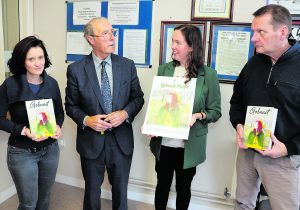
Con Lynch (2nd from left) paid a viist to Scoil Ghobnatan in Mallow last week, where he presented copies of ‘Gobnait’, a book detailing the people and places associate with St. Gobnait. Con is pictured with teacher Nollaig O’Keffee, Vice-Principal Eleanor Walsh, and Principal Donal O’Shea. Photo, S. Murphy.
Although St. Gobnait is well respected in the Mallow/Lombardstown/Glantane area, she is widely remembered and venerated in specific places along a route stretching from the Co. Galway island of Inisheer, to Dun Chaoin and Kilgobinet in Kerry, Ballyagran in Limerick, Kilgobinet in Waterford, and Abbeyswell and Clondrohid in Cork, to her final resting place in Ballyvourney. She is the Patron Saint of Ballyvourney and has been venerated there continuously for one thousand five hundred years.
The story of her Camino is the subject of a new book by Ballyvourney-born author, Cornelius Lynch, who vividly remembers childhood illnesses, such as being treated – not by a nurse or doctor – but by the application of St. Gobnait’s Measure to the affected area. The book records the stories, legends, local events relating to St. Gobnait, which Cornelius uncovered as he traversed Gobnait’s journey, in each of the areas with which she is associated. The book’s 245 colour photographs and maps help the reader to quickly get a good understanding of the ‘people and places associated with St. Gobnait’.
Gobnait was a young woman, living a life of prayer in a little enclosure in Inisheer, (probably in the late fifth century), when an angel informed her that she would find the ‘place of her resurrection’ in the spot where she would see nine white deer. She must have had extraordinary belief and trust in God, because she set out on her quest, went by sea to Ventry in the Dingle Peninsula and thence to Dun Chaoin where she saw three white deer. She obviously stayed there for a significant length of time before moving on to continue her search. We know that she stayed for a period of time in the places listed above because of evidence of her presence such as, a holy well bearing her name, or a fort or a little church and also by the fact that her Feast Day was traditionally celebrated in those places on 11th February.
Gobnait touched the lives of many in the places with which she is associated, and clearly made a lasting impact. Girls are named after her in Inisheer, Keel, Clondrohid and elsewhere. Many houses throughout Ireland bear her name; townlands and an entire parish (Kilgobinet near Dungarvan), bear her name. At least eight wells, six schools (including Scoil Ghobnatan, Mallow), five churches, three cemeteries (including St. Gobnait’s Cemetery Mallow), one G.A.A. Club, one Sports Centre, a nursing home, a hotel, a funeral home, a wood, a road, a naomhóg, a housing estate and a section of another and a sensory garden, are all named in her honour. Statues and images of Gobnait are to be seen in six different churches – including in St. Colman’s Cathedral in Cobh. She is featured in beautifully painted icons, and is depicted in stained glass windows in at least seven locations, including the Honan Chapel in U.C.C.
Some schools in areas associated with St. Gobnait wrote chapters for the book on St. Gobnait. Scoil Ghobnatan in Mallow and Glantane N.S. were among those schools, and the teachers involved were Nollaig O’Keeffe from Scoil Ghobnatan, and Maria Foley from Glantane N.S.
People have strong faith in Gobnait as an intercessor to effect healing, and an entire chapter of the book is devoted to cures that are recorded. Gobnait has a strong association with bees and is the patron saint of beekeepers. She is associated with five of Munster’s six counties and probably travelled through part of Tipperary on her long Camino and, hence, one could regard her as the Patron Saint of Munster.
A picture of Gobnait by Ballyvourney artist Maire O’Sullivan was specially commissioned for the cover of the book. It depicts Gobnait as a young woman, standing in the spot where Seamus Murphy’s famous statue of Gobnait now stands, and portrays the area as it might have looked 1,500 years ago when Gobnait lived there. A print of that painting (in varying sizes) can now be ordered online from www.corneliuslynchauthor.ie.
No profits accrue to the author from any of his books. To date, ‘Gobnait’ has generated more that €6,000, principally for the upkeep of St. Gobnait’s Shrine, and for a small number of other charitable groups.
Gobnait: People and Places Associated with St. Gobnait is available in some local shops, from Veritas in Cork city, and from the Trócaire office in 9 Cook Street, Cork. It can also be bought online from www.corneliuslynchauthor.ie.